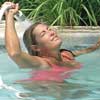|
| |
 | Swimming as an
exercise tones your muscles. It improves the back-support muscles and strengthens the
chest and shoulders. |
These
areas are undergoing development from the overuse of the muscles through
stretching backward, through the motion in the recovery portion of the crawl and butterfly
strokes. All of these movements are also good for loosening up the shoulders. So building
our muscles and making them stronger and more enduring requires the continuous use of more
of your body’s major muscle groups than do most other forms of exercise. through
stretching backward, through the motion in the recovery portion of the crawl and butterfly
strokes. All of these movements are also good for loosening up the shoulders. So building
our muscles and making them stronger and more enduring requires the continuous use of more
of your body’s major muscle groups than do most other forms of exercise.
 | By swimming, we use
the muscles of both the upper and lower body. The various strokes require contractions of
muscles of the arms, shoulders, chest, and upper back. Swimming provides a stimulus for
muscle growth that is superior to most land activities of an endurance nature. According
to authors Maglischo and Brennan, this is "because it is 1,000 times more dense than
air, water offers greater resistance to movement" (9).
|
 | Working out in the
water is also a great way to come back from a sports injury, recover from surgery, or keep
your fitness up while you are waiting to get back to your usual weight-bearing sport, like
running. |
Indeed, swimming has
a very important advantage to sports related injuries. As research indicates, swimmers are
subject to fewer injuries than participants in practically any other sport are. Many
runners, for example, are being forced to abandon their sports because their knees and hip
joints can’t tolerate the constant pounding. Joint and muscle injuries are less
prominent among swimmers because the water supports their bodies, thus alleviating the
punishing and jarring effects of weight bearing. People swim because they’re too weak
to run on dry land; after swimming for a while, they like it so much because they see
great results. We are using all of our muscles in the water, so we are developing more
solid muscle.
 | The swimming learning
curve is steeper than running, cycling or stair climbing, but it’s worth the effort
it takes to become proficient. Dr. Lewis G. Maharam, who practices sports medicine in New
York City, says: |
Swimming uses all of
the major muscle groups; it’s aerobic, it’s low impact and, if done correctly,
it’s probably the best exercise. Swimmers can also work their legs and trunk without
having to strain their joints, a boon for the elderly, the overweight, or those with
arthritis or lower-back pain. (Ritter 76)
|
  

Web Revised Friday, May 14, 1999
by Iva Haddad ihaddad@mail.gcccd.cc.ca.us
https://members.tripod.com/IvaHaddad/swimfor.htm
for CIS 212, Cuyamaca College
|